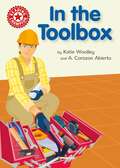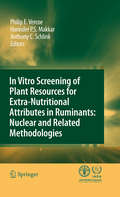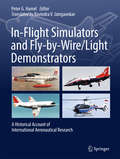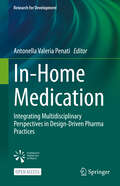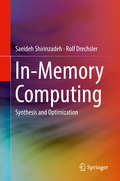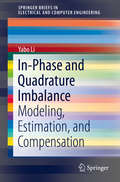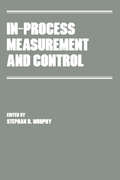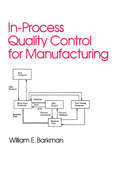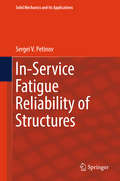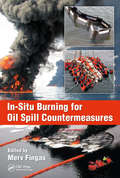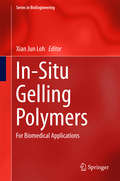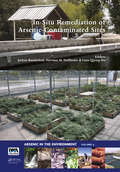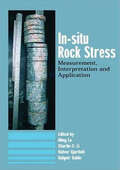- Table View
- List View
In the Looking Glass: Mirrors & Identity in Early America
by Rebecca K. Shrum“[An] utterly fascinating reading of the multiple uses and meanings of mirrors among European Americans, African Americans, and Native Americans.” —Journal of Social HistoryWhat did it mean, Rebecca K. Shrum asks, for people—long-accustomed to associating reflective surfaces with ritual and magic—to became as familiar with how they looked as they were with the appearance of other people? Fragmentary histories tantalize us with how early Americans—people of Native, European, and African descent—interacted with mirrors.Shrum argues that mirrors became objects through which white men asserted their claims to modernity, emphasizing mirrors as fulcrums of truth that enabled them to know and master themselves and their world. In claiming that mirrors revealed and substantiated their own enlightenment and rationality, white men sought to differentiate how they used mirrors from not only white women but also from Native Americans and African Americans, who had long claimed ownership of and the right to determine the meaning of mirrors for themselves. Mirrors thus played an important role in the construction of early American racial and gender hierarchies.Drawing from archival research, as well as archaeological studies, probate inventories, trade records, and visual sources, Shrum also assesses extant mirrors in museum collections through a material culture lens. Focusing on how mirrors were acquired in America and by whom, as well as the profound influence mirrors had, both individually and collectively, on the groups that embraced them, In the Looking Glass is a piece of innovative textual and visual scholarship.“A superb reflection of the many meanings held by an object usually taken for granted. Highly recommended.” —Choice
In the Looking Glass: Mirrors and Identity in Early America
by Rebecca K. ShrumHow mirrors shaped human identity in North America from the earliest European explorations.What did it mean, Rebecca K. Shrum asks, for people—long-accustomed to associating reflective surfaces with ritual and magic—to became as familiar with how they looked as they were with the appearance of other people? Fragmentary histories tantalize us with how early Americans—people of Native, European, and African descent—interacted with mirrors. Shrum argues that mirrors became objects through which white men asserted their claims to modernity, emphasizing mirrors as fulcrums of truth that enabled them to know and master themselves and their world. In claiming that mirrors revealed and substantiated their own enlightenment and rationality, white men sought to differentiate how they used mirrors from not only white women but also from Native Americans and African Americans, who had long claimed ownership of and the right to determine the meaning of mirrors for themselves. Mirrors thus played an important role in the construction of early American racial and gender hierarchies. Drawing from archival research, as well as archaeological studies, probate inventories, trade records, and visual sources, Shrum also assesses extant mirrors in museum collections through a material culture lens. Focusing on how mirrors were acquired in America and by whom, as well as the profound influence mirrors had, both individually and collectively, on the groups that embraced them, In the Looking Glass is a piece of innovative textual and visual scholarship.
In the Red
by Christopher SwiedlerA harrowing, pulse-pounding race for survival that New York Times bestselling author D. J. MacHale says “will leave you breathless.”Michael Prasad knows he shouldn’t go out on the Mars surface alone. It’s dangerous. His parents have forbidden it. And the anxiety he feels almost every time he puts on a spacesuit makes it nearly impossible for him to leave the safety of the colony.But when his best friend, Lilith, suggests they sneak out one night, he can’t resist the chance to prove everyone—including himself—wrong. As the two ride along the Mars surface in a stolen rover, miles from the colony, a massive solar flare hits the planet, knocking out power, communication, and navigation systems, and the magnetic field that protects the planet from the sun’s deadly radiation. Stranded hours from home with an already limited supply of food, water, and air, Michael and Lilith must risk everything if they’re to get back to the colony alive.
In the Shadow of the Moon: America, Russia, and the Hidden History of the Space Race
by Amy CherrixAn exhilarating dive into the secret history of humankind’s race to the moon, from acclaimed author Amy Cherrix. This fascinating and immersive read is perfect for fans of Steve Sheinkin’s Bomb and M. T. Anderson’s Symphony for the City of the Dead. You’ve heard of the space race, but do you know the whole story? The most ambitious race humankind has ever undertaken was masterminded in the shadows by two engineers on opposite sides of the Cold War—Wernher von Braun, a former Nazi officer living in the US, and Sergei Korolev, a Russian rocket designer once jailed for crimes against his country—and your textbooks probably never told you. Von Braun became an American hero, recognized the world over, while Korolev toiled in obscurity. These two brilliant rocketeers never met, but together they shaped the science of spaceflight and redefined modern warfare. From Stalin’s brutal Gulag prisons and Hitler’s concentration camps to Cape Canaveral and beyond, their simultaneous quests pushed science—and human ingenuity—to the breaking point. From Amy Cherrix comes the extraordinary hidden story of the space race and the bitter rivalry that launched humankind to the moon.
In the Shadows of State and Capital: The United Fruit Company, Popular Struggle, and Agrarian Restructuring in Ecuador, 1900-1995
by Steve StrifflerWinner of the 2001 President's Award of the Social Science History Association In the Shadows of State and Capital tells the story of how Ecuadorian peasants gained, and then lost, control of the banana industry. Providing an ethnographic history of the emergence of subcontracting within Latin American agriculture and of the central role played by class conflict in this process, Steve Striffler looks at the quintessential form of twentieth-century U. S. imperialism in the region--the banana industry and, in particular, the United Fruit Company (Chiquita). He argues that, even within this highly stratified industry, popular struggle has contributed greatly to processes of capitalist transformation and historical change. Striffler traces the entrance of United Fruit into Ecuador during the 1930s, its worker-induced departure in the 1960s, the troubled process through which contract farming emerged during the last half of the twentieth century, and the continuing struggles of those involved. To explore the influence of both peasant activism and state power on the withdrawal of multinational corporations from banana production, Striffler draws on state and popular archives, United Fruit documents, and extensive oral testimony from workers, peasants, political activists, plantation owners, United Fruit administrators, and state bureaucrats. Through an innovative melding of history and anthropology, he demonstrates that, although peasant-workers helped dismantle the foreign-owned plantation, they were unable to determine the broad contours through which the subsequent system of production--contract farming--emerged and transformed agrarian landscapes throughout Latin America. By revealing the banana industry's impact on processes of state formation in Latin America, In the Shadows of State and Capital will interest historians, anthropologists, and political scientists, as well as scholars of globalization and agrarian studies.
In the Time of Oil
by Mandana E. LimbertBefore the discovery of oil in the late 1960s, Oman was one of the poorest countries in the world, with only six kilometers of paved roads and one hospital. By the late 1970s, all that had changed as Oman used its new oil wealth to build a modern infrastructure. In the Time of Oil describes how people in Bahla, an oasis town in the interior of Oman, experienced this dramatic transformation following the discovery of oil, and how they now grapple with the prospect of this resource's future depletion. Focusing on shifting structures of governance and new forms of sociality as well as on the changes brought by mass schooling, piped water, and the fracturing of close ties with East Africa, Mandana Limbert shows how personal memories and local histories produce divergent notions about proper social conduct, piety, and gendered religiosity. With close attention to the subtleties of everyday life and the details of archival documents, poetry, and local histories, Limbert provides a rich historical ethnography of oil development, piety, and social life on the Arabian Peninsula.
In the Toolbox: Independent Reading Non-fiction Red 2 (Reading Champion #515)
by Katie WoolleyThis book is part of Reading Champion, a series carefully linked to book bands to encourage independent reading skills, developed with UCL Institute of Education (IOE)In the Toolbox is a non-fiction text reporting on the tools used by a builder. The repeated sentence structure offers readers the opportunity for a first independent reading experience with the support of the illustrations.Reading Champion offers independent reading books for children to practise and reinforce their developing reading skills.This early non-fiction text is accompanied by engaging artwork and a reading activity. Each book has been carefully graded so that it can be matched to a child's reading ability, encouraging reading for pleasure.
In the Watches of the Night: Life in the Nocturnal City, 1820–1930 (Historical Studies of Urban America)
by Peter C. BaldwinBefore skyscrapers and streetlights glowed at all hours, American cities fell into inky blackness with each setting of the sun. But over the course of the nineteenth and early twentieth century, new technologies began to light up streets, sidewalks, buildings, and public spaces. Peter C. Baldwin’s evocative book depicts the changing experience of the urban night over this period, visiting a host of actors—scavengers, newsboys, and mashers alike—in the nocturnal city.Baldwin examines work, crime, transportation, and leisure as he moves through the gaslight era, exploring the spread of modern police forces and the emergence of late-night entertainment, to the era of electricity, when social campaigns sought to remove women and children from public areas at night. While many people celebrated the transition from darkness to light as the arrival of twenty-four hours of daytime, Baldwin shows that certain social patterns remained, including the danger of street crime and the skewed gender profile of night work. Sweeping us from concert halls and brothels to streetcars and industrial forges, In the Watches of the Night is an illuminating study of a vital era in American urban history.
In through the Side Door: Fifty Years of Women in Interaction Design
by Erin MaloneThe vital story of how women designers and researchers pioneered the field of interaction and user experience design for software and digital interfaces.Framed against the backdrop of contemporary waves of feminism and the history of computing design, In through the Side Door foregrounds the stories of the women working in the field of computing and the emergent discipline of interaction design as the graphical user interface was developed. Erin Malone begins with a handful of pioneers who brought to the field various methods from a variety of backgrounds including design, technical communication, social psychology, ethnography, information science, and mechanical engineering. Moving into the early days of desktop computing, the book highlights the women on the teams inventing contemporary desktop computer interfaces and related tools, including those at Xerox PARC, Apple&’s Human Interface Group, and Microsoft.Malone takes the reader through the invention of the World Wide Web, the third wave of feminism, and the dot-com boom and bust. Coming up to contemporary times, the book features women working on the web, designing equipment interfaces, and working in voice UX, mobile design, and civic design, and continues with the up-and-coming leaders driving social impact, changing human-centered design and research, and working to be accountable for the harms of contemporary software products. Along the way, the author also touches on the challenges and biases women have faced in the workplace and continue to encounter despite cultural and sociological advancements.
In vitro screening of plant resources for extra-nutritional attributes in ruminants: nuclear and related methodologies
by Harinder P.S. Makkar Philip E. Vercoe Anthony C. SchlinkThe aim of this manual is to provide a comprehensive guide to the methods involved in collecting, preparing and screening plants for bioactive properties for manipulating key ruminal fermentation pathways and against gastrointestinal pathogens. The manual will better equip the reader with methodological approaches to initiate screening programmes to test for bioactivity in native plants and find 'natural' alternatives to chemicals for manipulating ruminal fermentation and gut health. The manual provides isotopic and non-isotopic techniques to efficiently screen plants or plant parts for a range of potential bioactives for livestock production. Each chapter has been contributed by experts in the field and methods have been presented in a format that is easily reproducible in the laboratory. It is hoped that this manual will be of great value to students, researchers and those involved in developing efficient and environmentally friendly livestock production systems.
In-Flight Simulators and Fly-by-Wire/Light Demonstrators
by Peter G. HamelThis book offers the first complete account of more than sixty years of international research on In-Flight Simulation and related development of electronic and electro-optic flight control system technologies ("Fly-by-Wire" and "Fly-by-Light"). They have provided a versatile and experimental procedure that is of particular importance for verification, optimization, and evaluation of flying qualities and flight safety of manned or unmanned aircraft systems. Extensive coverage is given in the book to both fundamental information related to flight testing and state-of-the-art advances in the design and implementation of electronic and electro-optic flight control systems, which have made In-Flight Simulation possible. Written by experts, the respective chapters clearly show the interdependence between various aeronautical disciplines and in-flight simulation methods. Taken together, they form a truly multidisciplinary book that addresses the needs of not just flight test engineers, but also other aeronautical scientists, engineers and project managers and historians as well. Students with a general interest in aeronautics as well as researchers in countries with growing aeronautical ambitions will also find the book useful. The omission of mathematical equations and in-depth theoretical discussions in favor of fresh discussions on innovative experiments, together with the inclusion of anecdotes and fascinating photos, make this book not only an enjoyable read, but also an important incentive to future research. The book, translated from the German by Ravindra Jategaonkar, is an extended and revised English edition of the book Fliegende Simulatoren und Technologietr#65533;ger , edited by Peter Hamel and published by Appelhans in 2014.
In-Game: From Immersion to Incorporation
by Gordon CallejaAn investigation of what makes digital games engaging to players and a reexamination of the concept of immersion.Digital games offer a vast range of engaging experiences, from the serene exploration of beautifully rendered landscapes to the deeply cognitive challenges presented by strategic simulations to the adrenaline rush of competitive team-based shoot-outs. Digital games enable experiences that are considerably different from a reader's engagement with literature or a moviegoer's experience of a movie. In In-Game, Gordon Calleja examines what exactly it is that makes digital games so uniquely involving and offers a new, more precise, and game-specific formulation of this involvement. One of the most commonly yet vaguely deployed concepts in the industry and academia alike is immersion—a player's sensation of inhabiting the space represented onscreen. Overuse of this term has diminished its analytical value and confused its meaning, both in analysis and design. Rather than conceiving of immersion as a single experience, Calleja views it as blending different experiential phenomena afforded by involving gameplay. He proposes a framework (based on qualitative research) to describe these phenomena: the player involvement model. This model encompasses two constituent temporal phases—the macro, representing offline involvement, and the micro, representing moment-to-moment involvement during gameplay—as well as six dimensions of player involvement: kinesthetic, spatial, shared, narrative, affective, and ludic. The intensified and internalized experiential blend can culminate in incorporation—a concept that Calleja proposes as an alternative to the problematic immersion. Incorporation, he argues, is a more accurate metaphor, providing a robust foundation for future research and design.
In-Hand Object Localization and Control: Enabling Dexterous Manipulation with Robotic Hands (Springer Tracts in Advanced Robotics #149)
by Martin PfanneThis book introduces a novel model-based dexterous manipulation framework, which, thanks to its precision and versatility, significantly advances the capabilities of robotic hands compared to the previous state of the art. This is achieved by combining a novel grasp state estimation algorithm, the first to integrate information from tactile sensing, proprioception and vision, with an impedance-based in-hand object controller, which enables leading manipulation capabilities, including finger gaiting. The developed concept is implemented on one of the most advanced robotic manipulators, the DLR humanoid robot David, and evaluated in a range of challenging real-world manipulation scenarios and tasks. This book greatly benefits researchers in the field of robotics that study robotic hands and dexterous manipulation topics, as well as developers and engineers working on industrial automation applications involving grippers and robotic manipulators.
In-Home Medication: Integrating Multidisciplinary Perspectives in Design-Driven Pharma Practices (Research for Development)
by Antonella Valeria PenatiThis is an open access book. This book provides a distinctive perspective on the daily utilization and consumption of medicines and drugs. It seamlessly integrates the research traditions of the medical and pharmaceutical realms with the approach of fostering the relationship between users and products, a characteristic of design and user studies. By applying a diverse range of expertise, the authors endeavor to reestablish the interconnectedness of issues that place the drug and the indispensable information for its use directly into the hands of the patient. The primary objective is to formulate an initial set of recommendations and compile a repertoire of best practices. Consequently, this book becomes an indispensable resource for students, professionals, and academics engaged in design culture, as well as those operating within the healthcare domain, such as the pharmaceutical industry, medical practitioners, and pharmacists. It is equally valuable for individuals working in institutions responsible for regulating medicines and overseeing their presence in the market. As a comprehensive guide, this book serves as an essential read, offering insights that bridge the gap between various sectors involved in the intricate landscape of medicine and drug consumption.
In-Memory Computing Hardware Accelerators for Data-Intensive Applications
by Baker Mohammad Yasmin HalawaniThis book describes the state-of-the-art of technology and research on In-Memory Computing Hardware Accelerators for Data-Intensive Applications. The authors discuss how processing-centric computing has become insufficient to meet target requirements and how Memory-centric computing may be better suited for the needs of current applications. This reveals for readers how current and emerging memory technologies are causing a shift in the computing paradigm. The authors do deep-dive discussions on volatile and non-volatile memory technologies, covering their basic memory cell structures, operations, different computational memory designs and the challenges associated with them. Specific case studies and potential applications are provided along with their current status and commercial availability in the market.
In-Memory Computing: Synthesis and Optimization
by Rolf Drechsler Saeideh ShirinzadehThis book describes a comprehensive approach for synthesis and optimization of logic-in-memory computing hardware and architectures using memristive devices, which creates a firm foundation for practical applications. Readers will get familiar with a new generation of computer architectures that potentially can perform faster, as the necessity for communication between the processor and memory is surpassed. The discussion includes various synthesis methodologies and optimization algorithms targeting implementation cost metrics including latency and area overhead as well as the reliability issue caused by short memory lifetime.Presents a comprehensive synthesis flow for the emerging field of logic-in-memory computing;Describes automated compilation of programmable logic-in-memory computer architectures;Includes several effective optimization algorithm also applicable to classical logic synthesis;Investigates unbalanced write traffic in logic-in-memory architectures and describes wear leveling approaches to alleviate it.
In-Memory-Computing: Synthese und Optimierung
by Rolf Drechsler Saeideh ShirinzadehDieses Buch beschreibt einen umfassenden Ansatz für die Synthese und Optimierung von Logic-in-Memory-Computing-Hardware und -Architekturen mit memristiven Bauelementen, der eine solide Grundlage für praktische Anwendungen schafft. Die Leser werden mit einer neuen Generation von Computerarchitekturen vertraut gemacht, die potenziell schneller arbeiten können, da die Notwendigkeit der Kommunikation zwischen Prozessor und Speicher überwunden wird. Die Diskussion umfasst verschiedene Synthesemethoden und Optimierungsalgorithmen, die auf Implementierungskostenmetriken wie Latenzzeit und Flächen abzielen, sowie das Problem der Zuverlässigkeit, das durch die kurze Lebensdauer des Speichers verursacht wird. Präsentiert einen umfassenden Synthesefluss für das aufkommende Feld des Logic-in-Memory-Computings; Beschreibt die automatische Kompilierung von programmierbaren Logik-in-Memory-Computerarchitekturen; Enthält mehrere effektive Optimierungsalgorithmen, die auch auf die klassische Logiksynthese anwendbar sind; Untersucht den unausgewogenen Schreibverkehr in Logic-in-Memory-Architekturen und beschreibt Ansätze zum Verschleißausgleich, um diesen zu verringern.
In-Phase and Quadrature Imbalance
by Yabo LiThis book provides a unified IQ imbalance model and systematically reviews the existing estimation and compensation schemes. It covers the different assumptions and approaches that lead to many models of IQ imbalance. In wireless communication systems, the In-phase and Quadrature (IQ) modulator and demodulator are usually used as transmitter (TX) and receiver (RX), respectively. For Digital-to-Analog Converter (DAC) and Analog-to-Digital Converter (ADC) limited systems, such as multi-giga-hertz bandwidth millimeter-wave systems, using analog modulator and demodulator is still a low power and low cost solution. In these kind of systems, the IQ imbalance cannot be ignored. By explaining a variety of assumptions and models of IQ imbalance, the author provides a helpful resource for those who are new to this complex topic. The intended audience of this book is researchers working on the IQ imbalance as well as the system design engineers who use IQ imbalance in their systems.
In-Process Measurement and Control
by Stephen MurphyThis book attempts to encompass in-process measurement and control holistically as opposed to dealing with the bits and pieces. It discusses various types of sensors and strategies for using the data derived from the sensors in a closed-loop feedback arrangement.
In-Process Quality Control for Manufacturing
by William BarkmanThis book provides a common sense computer-oriented, determinstic manufacturing approach, which employs statistics but does not require a background in this area, theoretical mathematics or computer science to understand and apply. In a clear, easy-to-read style, this reference text highlights critical parameters that have a major impact upon process quality and identifies sensors for parameter monitoring; discusses appropriate applications of deterministic techniques to many manifacturing situations ranging from simple to complex; includes chapter summaries, helpful illustrations and numerous citations to ehnance comprehension and facilitate further research. Written from the perspective of a practioner who 'knows how to make parts'; presenting practical solutions to manufacturing problems it is essential reading for industrial, quality control, electrical and electronics, mechancial, manufacturing and systems engineers/managers and undergraduate and graduate-level students in the above areas.
In-Service Fatigue Reliability of Structures (Solid Mechanics and Its Applications #251)
by Sergei V. PetinovThis book provides readers with the latest know-how and tools needed to assess the in-service strength and reliability of welded structures. It addresses the two principal mechanisms of structural material deterioration, fatigue and corrosion, which affect the in-service behavior of structures. In this regard, the primary focus is on fatigue in connection with various structural failure scenarios. Realistic and typical examples of welded structures’ design and residual life assessment are used throughout the book in order to show readers the complexity of real-world assessments. The book offers a valuable resource for master’s students in mechanical and civil engineering, and for engineers whose work involves fatigue design and in-service inspections of welded structures.
In-Situ Burning for Oil Spill Countermeasures
by Merv FingasShelving Guide: Environmental Engineering In-situ burning is recognized as a viable alternative for cleaning up oil spills on land and water. It can rapidly reduce the volume of spilled oil and eliminate the need to collect, store, transport, and dispose of recovered oil, and can also shorten the response time to a spill, thus reducing the chances that the spill will spread on the water surface or further into land. This book will serve as a comprehensive reference for all aspects of in-situ burning of oil spills and include the scientific aspects of the burning process and the related effects, as well as practical information about the procedures to be followed and equipment required for carrying out an in-situ burn. Features Serves as a complete source of information on in-situ burning as well as practical guide on how to implement the procedures. Explains procedures for burning in different situations, including on water, land, and ice. Provides information on worker health and safety precautions during burning. Covers several different types of emissions, their environmental fate, and how to monitor them. Includes numerous illustrative case studies.
In-Situ Gelling Polymers
by Xian Jun LohThis book presents the research involving in situ gelling polymers and can be used as a guidebook for academics, industrialists and postgraduates interested in this area. This work summaries the academic contributions from the top authorities in the field and explore the fundamental principles of in situ gelling polymeric networks, along with examples of their major applications. This book aims to provide an up-to-date resource of in situ gelling polymer research.
In-Situ Remediation of Arsenic-Contaminated Sites (Arsenic in the environment)
by Jochen Bundschuh Hartmut M. Holländer Lena Qiying MaProviding an introduction, the scientific background, case studies and future perspectives of in-situ arsenic remediation technologies for soils, soil water and groundwater at geogenic and anthropogenic contaminated sites. The case studies present in-situ technologies about natural arsenic, specifically arsenate and arsenite, but also about organic arsenic compounds. This work covers geochemical, microbiological and plant ecological solutions for arsenic remediation.It will serve as a standard textbook for (post-)graduate students and researchers in the field of Environmental Sciences and Hydrogeochemistry as well as researchers, engineers, environmental scientists and chemists, toxicologists, medical scientists and even for general public seeking an in-depth view of arsenic which had been classed as a carcinogen. This book aims to stimulate awareness among administrators, policy makers and company executives of in-situ remediation technologies at sites contamined by arsenic and to improve the international cooperation on the subject.
In-Situ Rock Stress: International Symposium on In-Situ Rock Stress, Trondheim, Norway,19-21 June 2006
by Ming Lu Charlie C. Li Halvor Kjørholt Halgeir DahleUnderstanding the stress state in the earth's crust is crucial for engineers working in rock, particularly with regard to underground construction. Experience shows that an adequately high horizontal in-situ stress has a positive effect in stabilizing large span rock caverns close to the ground surface. On the other hand, high stresses resulting fr





